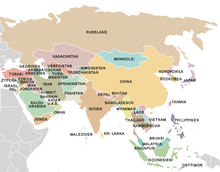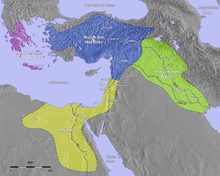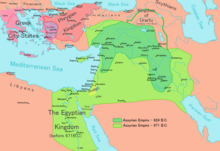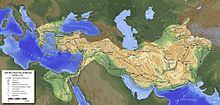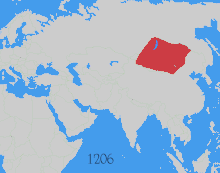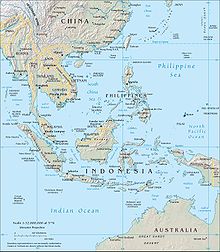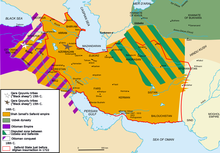History of asia
The history of Asia can be divided into four major epochs:
After the spread of the early hominins like Homo erectus from Africa to Asia during the Old Paleolithic and the later spread of Homo sapiens in the Middle Paleolithic , they settled down during the Neolithic . As the population settled down, the population increased, the first cities appeared and the early advanced civilizations of Asia could establish themselves in the alluvial lands of Mesopotamia, the Indus and the Yellow River. You know writing and bronze processing ( Bronze Age ). The first civilizations of the subsequent Iron Age are known as the classical advanced civilizations of antiquity. Their decline is caused by the great nomadic migrations of the beginning (European) Middle Ages , which in Asia is mainly characterized by the spread of Islam and the cultural radiance of the Chinese and Indian cultural areas. With the European voyages of discovery, the modern age begins , which is determined by the immense technological and scientific development in Europe and its expansion based on it up to the end of European domination after the world wars.
This terminology is characterized by a certain Eurocentrism, but thanks to its usage it also serves to provide clarity.
introduction
At first, Asia only appeared as a coherent space from a foreign perspective. The ancient people of the Near East used this term, presumably derived from the Assyrian word for sunrise, to denote the countries in the east that included the legendary India.
The steppe and desert belt of Central Asia, which lies between the tundric forest areas of Siberia and the subtropical and tropical regions, facilitated the spread of nomadic peoples as well as cultural exchange and later intercontinental trade. In contrast, the high mountains of the Himalayas prevented access to Southeast Asia and the subcontinent India. In contrast to the more northerly continental climate, these more southern regions are determined by the monsoons . The denser vegetation caused by this, together with the highlands of the Decan in India and of Annam in Southeast Asia, made the formation of larger empires difficult, such as in Central Asia or China. In contrast, the regular winds of the monsoons in the Indian Ocean also made shipping and trade easier.
The very different sources often prevent historians from taking a single look at the past. Asia is archeologically developed in very different ways. While China and the cities along the Silk Road are rather well developed, large parts of Asia have not been adequately explored. Likewise, in contrast to the cuneiform scripts of Mesopotamia and the hieroglyphs of Egypt, the script of the Indus culture has not been deciphered, which rules out a similarly deep insight into this culture. The script only spread to Central Asia (Turkish runes) and Southeast Asia in the course of the 1st century AD, so that sources from neighboring countries such as China have to be used for the early period. Here the sources are not only in need of their author, as in the case of ruler's inscriptions, but also need to be interpreted from an outside perspective. Only with the reports of missionaries and the files of the European colonial rulers, which are often not in the respective countries, but in Europe's archives, do the written evidence multiply. Linguistic and genetic studies are becoming increasingly important for the spread and kinship of peoples.
prehistory
Hominins / Paleolithic
Finds of Homo erectus from Java (" Java man ") are now dated to an age of almost 1.8 million years. Asia was therefore populated very early by a species of the genus Homo . Homo erectus , who immigrated from Africa , was later replaced by anatomically modern humans ( Homo sapiens ), who also immigrated from Africa in a second wave of emigration.
Locations of hominine fossils include:
- China: Zhoukoudian (" Peking man ") and Dali (" Dali man " over 300,000 years old) (See also: List of hominine fossils of the Paleolithic in China , List of Paleolithic sites in China )
- India: axes and among others in the Soan valley and Beas valley, but also far in the south
- Russia: Denisova Cave ( Denisova Man )
- Georgia: Dmanisi ( Hominin Fossils of Dmanisi )
- Indonesia: Flores ( Homo floresiensis )
- around 100,000 years before today: The spread of humans beyond Africa began ( out-of-Africa theory ). During the Middle Paleolithic , anatomically modern humans, who emerged in East Africa about 200,000 years ago, reached the Middle East. The sites are Qafzeh and Skhul in Israel . From there he reached Australia along the coast of South Asia 60,000 years ago (Malakunanja II in Arnhem Land and Lake Mungo). As a result, he turned north. Apparently 40,000 year old traces have been found in the interior of Southeast Asia, 30,000 years ago in China and 26,000 years ago in Northeast Asia. It seems that around 8000 BC Jōmon culture originating in Japan can be traced back to an immigration from Australia. By 3500 BC Polynesia was settled.
- around 50,000 years ago: It is believed that a complex language developed at this time. It is further assumed that with the Upper Palaeolithic from 40,000 BC. Connected development of culture ( burials , painting ) and hunter societies related. This progress led to an expansion of the area inhabited by humans. The archaeological evidence for the now fully modern man is sparse, however; the oldest find was made in Lebanon ( Ksar Akil ) and dated to an age of around 42,000 years.
Neolithic Revolution
Even before the actual transition to agriculture and cattle breeding, a hunter culture began around 12,000 BC. To settle in Palestine ( Natufien , Epipalaeolithic , Mesolithic ). After that, probably triggered by a decline in large game, humans began from 8000 BC. To practice agriculture in the subtropical regions of Asia. First of all, this happens on the mountain slopes of the Near East ( Fertile Crescent ), where rain-fed agriculture is increasingly being practiced. Grains and pets are domesticated, and ceramics are increasingly used. This Neolithic revolution leads to a huge increase in the human population. It is estimated that the population grew from around 6 million at the beginning to around 250 million in the 1st century AD.
- Middle East: The earliest and most famous finds are those of Jericho (from 9500 BC) and Çatalhöyük (from 7500 BC). In the Middle East, the Neolithic farming communities are based on barley and wheat, as well as sheep and goats. The development of the rotating potter's wheel, a forerunner from the Obed period (from 5900 BC), represents a significant technological advance .
- South Asia: The Mehrgarh culture between the Indus and the Zagros Mountains (from 7000 BC) is regarded as the forerunner of the Indus culture.
- East Asia: In contrast, the Neolithic cultures in East Asia are based on millet, rice, pigs and poultry. The earliest is that of Jomon in Japan, which produces high-quality ceramics particularly early. In northern China, the Hemudu culture (from 7000 BC), the Yangshao culture (from 5000 BC) and the Longshan culture (from 3000 BC) follow one after the other on the Yellow River is considered the forerunner of the later Chinese high culture.
Early civilizations
Important early civilizations were on the Indus and the Huanghe. Presumably, climatic conditions led to the Neolithization and thus an increase in populations together with the increasing Aridization to the concentration of the people in the large river valleys. The intensity of the irrigation work required has encouraged the formation of political and religious hierarchies in cities. With the displacement of the cattle breeders from the regions that could be used for agriculture, the steppe areas were populated by shepherds and nomads . The early advanced civilizations differ from other forms of life primarily in their centralized economy (food collection and redistribution) and the development of writing. The increasing use of metals goes hand in hand with this in the early advanced cultures of the ancient world . At around the same time, the bicycle is increasingly being used for transport. The need for raw materials such as ores and wood, the development of cities, businesses and the simultaneous easing of transport by bike, but above all by shipping close to the coast, stimulate trade.
Middle East
- 3500 BC Chr .: In Mesopotamia first signs of irrigation can be seen. Presumably shortly afterwards the Sumerians immigrated to Mesopotamia from the east . They establish the first high culture ever. Around 3400 BC The script, the fast turning potter's wheel and clay bricks are invented. With the construction of the temple of Uruk around 3000 BC The first monumental building in history is built ( Eanna ).
- 3000 BC BC: The Semites , who presumably come from Sinai and the Arabian Peninsula, begin to spread in the Middle East. They advance into what will later become Palestine and Mesopotamia, where the Sumerian city-states are conquered by the Akkadians . Akkade also conquers the Sumer-independent empire of Elam . In northern Mesopotamia they probably make up a large part of the population of around 1800 BC. The ancient Assyrian empire . At the same time in the south the Babylonian Empire inherited the Sumerian Third Dynasty of Ur .
- 2200 BC Chr .: oasis culture (Transoxania) in eastern Iran.
- 2000 BC BC: A first wave of Indo-Europeans penetrates into northern Mesopotamia ( Hurritans ), whose most important empire is that of Mitanni . Others reach Asia Minor and found the Hittite Empire . The Indo-European aristocratic societies are characterized by the use of chariots, which is made possible by the invention of the spoked wheel and offers a considerable military advantage (cf. Hyksos and Amoriter ).
- 1200 BC Chr .: Around the Mediterranean Sea, the Indo-Europeans cause a migration of peoples, which strongly affects the Bronze Age cultures ( sea peoples ). The use of iron spreads around the Mediterranean. Armenians and Phrygians migrate to Asia Minor and destroy the Hittite Empire. Around the same time, the Urartu Empire was formed and the Semitic Aramaeans appeared in Syria . In this confusing phase, the Assyrian Empire again becomes the determining power.
Indus culture
- 2600 BC BC: The Neolithic arable cultures on the Indus , the earliest of which was that of Mehrgarh , increasingly show a standardization of features that are typical of the Harappa and Mohenjodaro sites . It can be assumed that hierarchies and larger political units formed as in Mesopotamia , but the lack of decipherment of the script of the Indus culture allows only guesswork. In the course of the second millennium, there is a cultural decline, which is presumably due to ecological problems, including a decrease in rainfall.
- 1500 BC Chr .: Indo-Europeans gradually immigrate to the five rivers land ( Punjab ).
China
- 1600 BC Chr .: In the 17th century before our time, the first Bronze Age and written culture emerged at Huang He. This corresponds to the Shang dynasty of the Chinese tradition. It is said to have been preceded by the Xia dynasty , whose classification in the archaeological finds is controversial.
- 1000 BC Chr .: A regional ruler or previous vassal overthrows the previous rulers and founds the Zhou dynasty . It is characterized by a strong kingship and a noble society using chariots. Under the pressure of the growing nomads in the north (presumably forerunners of the Hsiung Nu) it comes around 771 BC. To move the capital to the east (Luoyang). During the dynasty now known as the Eastern Zhou, the central power gradually declined ( the spring and autumn annals ).
Classical high cultures of Asia
The scientific and technological development that has accelerated since the emergence of the early advanced civilizations, especially the spread of iron processing, allowed the emergence of larger empires. Since the 9./8. Century BC Phoenicians and Greeks opened the Mediterranean for their trade and founded colonies. The Greeks in particular also used this to export the surplus population of their cities. By the middle of the 2nd century BC, the entire Mediterranean area had been incorporated into the Roman Empire , the cohesion of which was ensured by systematic road construction and the sea route across the Mediterranean. Large empires are now also emerging in the other cultural areas. Since the 6th century BC The Persian Empire and its successors, in northern India in the 3rd century the Maurya Empire , which was the first to conquer almost all of India for a short time and was founded around 200 BC. The China of the Han Dynasty .
Religion is another way of strengthening cohesion in these realms. The founders of reformist or new theological teachings such as Zarathustra or Siddharta Gautama became founders of religions, as the rulers in Persia and India consciously promoted the dissemination of their ideas. In China, the Han used the teachings of Confucius, continued by Mengzi, to train officials. In a striking simultaneity of events, they lived at the beginning of this epoch around 500 BC, as did the first Greek natural philosophers (e.g. Heraclitus ) or (a little earlier) the important Jewish prophet Isaiah .
One reason may have been that with the expansion of these classical empires of antiquity, the gaps between the cultural spaces are closing for the first time and the dissemination of ideas is further facilitated. For the first time a transcontinental trade arises. Via the Silk Road and the Indian Ocean, spices and silk get to the west, precious metals, glass and raw materials to the east.
Persia, 6th century BC BC to 6th century AD
The area of today's Iran formed a geographical area since the 6th century BC, which invited to be ruled by an empire. The Medes, Persians and their successors belonged to the Indo-European group of Iranians like the nomadic Cimmerians , Scythians and Sarmatians who lived further north . The invention of the saddle and stirrup made it possible to use mounted warriors from around the Parthian period.
- 612 BC BC: The Medes conquer the Assyrian capital Nineveh and destroy the Assyrian Empire.
- 550 BC Chr .: Cyrus II rises against the Medes and founds the Persian Empire , which conquered Mesopotamia, Syria and Egypt and thus forms the first great empire in history. A short time later, internal unrest led to the seizure of power by Darius I, who founded the Achaemenid dynasty . With the Persian Empire, whose rulers ensure the safety of the caravan routes, trade between India and Mesopotamia experienced an upswing.
- 333 BC Chr .: Alexander of Macedonia begins the conquest of the Persian Empire and after his death Hellenic successor empires are formed up to India (see Hellenism ).
- 247 BC Chr .: In the Seleucid Empire the Parthians make themselves independent. Around the same time, the Hellenistic Graeco-Bactrian empire breaks away from the Seleucids.
- 224: Ardashir I founds the Sassanid dynasty, which becomes the main rival of the Byzantine Empire .
Ancient India, 5th Century BC BC to 5th century AD
Just as Iran represented a coherent geographical area that repeatedly invited the formation of empires, so did the Indus and Ganga valleys in India. The highlands of the Dekhan formed a natural border, which the great empires of the Ganges plain could only get under control for a short time . In the "Vedic Era" (named after the most important testimony, the Rigveda ) since the beginning of the immigration of or the conquest by Indo-Europeans ( Aryans ) in the Indus valley, smaller empires emerged in the Indus and later the Gangestal, which know writing and iron processing . This contrasted with the empires of southern India, whose population spoke Dravidian languages, presumably related to that of the Indus culture and perhaps even to that of Elams or Sumer.
- 500 BC BC: The principalities called Mahajanapadas are conquered by the empire of Magadha on the Ganges .
- 326 BC BC: The Magadha Empire fell into crisis and the Maurya dynasty came to power. Under its most important ruler, Emperor Ashoka (reign: 268–232 BC), India experienced its first heyday and Buddhism spreads. After Ashoka's death, the empire fell apart and northern India was influenced for a long time by empires emerging in Bactria and on the Indus ( Indo-Greeks , Saken , Kushana ).
- Around the birth of Christ: In southern India, an intensification of rice cultivation creates the basis for the emergence of territorial empires in the more tropical regions. Initially largely unaffected by the Aryan north, the "Dravidian" empires of Kalinga and Shatavahana emerged in southern India .
- 350: The second great empire of ancient Indian expands in the former core area of the Magadha empire. The time of the Gupta is considered to be a classical period, or even the “Golden Age”, characterized by a revival of Hinduism, but also by tolerance. The invasion of another nomadic people, the so-called Alchon group (who cannot simply be equated with the Hephtalites ), leads to the downfall of this empire.
Han Dynasty China, 3rd Century BC BC to 3rd century AD
From around 500 BC During the Warring States' War, the use of iron expanded. The regional princes raised standing armies and increasingly began to question the authority of the late Zhou kings.
- 221 BC BC: The empire of Qin on the Wei becomes a hegemonic power and finally conquers all empires on the Huang He that are shaped by Chinese culture.
- 206 BC Chr .: Poor harvests and tax pressure lead to uprisings in the course of which the first emperor of the Han dynasty comes to power. China is finally unified and experiences a tremendous upswing and a dramatic increase in population based on the increasing use of iron plows, draft animals and irrigation cultivation. Under the Han an official body shaped by Confucius is created and the administration is centralized. There is an expansion to Korea and North Vietnam , which, although only loosely connected to the China of the Han, are strongly influenced by their cultural influence. In addition, the countries on the Yangtze are systematically developed.
- 7 AD A brief interregnum under Wan-Mang was followed by the late phase in which the emperors increasingly lost power and eunuchs gained influence at court. The last Han abdicated at around 220, after the empire had already de facto split into three parts.
middle Ages
Strictly speaking, the term is not applicable, but it is also used for all cultures to identify intermediate phases between the classical cultures and the later flourishing empires of the modern era. Up to the turn of the century, apart from China, the history of Asia was shaped by the expansion of the Indo-Europeans. Now nomads from Central Asia determine the picture. China as well as India and Europe were affected. Until the appearance of the Mongols, China in particular was mostly divided into a northern and southern part with rapidly changing dynasties, with those of the north being founded by nomads who subsequently quickly adopted Chinese culture (Sinization). The Tang Dynasty was an exception. Almost afterwards, Islam spread to Central Asia with the Arabs. The takeover of Islam by the expanding Turkish peoples and the Mongols led to a second wave of conquests, in the course of which Islam reached India and finally the three great "powder empires" emerged: Ottoman Empire, Persia and that of the Mughals in India. In Japan the development is rather separate. Southeast Asia is influenced partly by China and partly by India. The Hsiung-Nu epoch follows roughly in East Asia, two phases in which first the Turkish and then the Mongolian language family expand.
The Xiongnu, nomadic people of Central Asia until the 5th century
Since the last centuries before Christianity, various rapidly successive large empires of nomads have been known in the steppe areas between Manchuria and Lake Baikal, as well as the Altai and Tian Shan mountains. Under energetic rulers, these empires, most likely to be characterized as tribal federations, expanded just as quickly as they disintegrated again under their successors. Written form and administration were just as rare as urbanity. The cities along the Silk Road are an exception to the latter.
- 318 BC Chr .: First documented mention of the Xiongnu (Hsiung-Nu), whose center of power was south of Lake Baikal. The pressure of these nomads leads to the first fortifications of the northern border of China, the forerunner of the Great Wall. They defeat 174 BC The Yuezhi (Tocharer), the 160 BC. Move west and found the Kushan Empire in Bactria . With the strengthening of China under the Han dynasty, the Xiongnu were pushed back in the course of the 1st century AD without disappearing completely. After the fall of China under the late Han, parts of northern China come under the rule of nomads, who are rapidly becoming Sinic. In 311 the Chinese capital Luoyang is destroyed by them. The similarity of names between the Xiongnu and the Huns led to the conclusion that they were related; however, an ethnic match is now very doubtful. This agreement can possibly be traced back to the fact that different peoples used this name to strengthen their legitimacy.
- 155 AD: The Xianbei , who have lived in Manchuria since the 3rd century BC, conquer parts of the crumbling Xiongnu Empire. A part of this people, the Toba , founded the Northern Wei Dynasty in northern China in 439.
- 402: The Yuan-Yuan , more native to what is now Mongolia, become the dominant power. She-Luan is the first ruler to assume the title of Khagan (Khan). A certain institutionalization of the rule of nomads above the tribal level seems to go hand in hand with this new title, which has since been used. Around 520 her empire is divided into a western and an eastern part.
Turkic peoples, East and Central Asia 6th to 12th centuries
- 552: Under the first known by name rulers Bumin the originating from the area of the Altai Mountains solve Göktürks with a victorious battle of the supremacy of the Juan-Juan and found an empire stretching from North Korea to the Black Sea. In contrast to the previous nomadic peoples, they belong to their own language group, through which the Turkic peoples form their own group. They were the first nomads in East Asia to master iron processing. As early as 584, the empire was divided into a western and an eastern part.
- Around 560: The Hephthalite empire and thus the last rule of the so-called Iranian Huns (see Chionites , Kidarites , Alchon and Nezak ) falls under the attack of the Sassanids and Gök Turks.
- 618: With the rise of the Chinese Tang dynasty , the Turks came under Chinese rule until 659. China is united under the Tang and expansive again. Not only does it conquer Central Asia, but it also exerts a strong cultural influence on East and South Asia through the activities of Chinese merchants. The trade benefits from the expansion of the trade, especially the porcelain and silk production. The strong central power ensured a connection between the economic centers of the empire in the north and south by building the so-called imperial canals. With the waning of the Tang rule in the course of the 9th century, a renaissance of the Turkish Empire went hand in hand.
- 745: The Uyghur , some people related with the Turks Oguz , gain their independence and become the hegemonic power until their power by 840 of the Kyrgyz is broken.
- 790: The Tibetan kingship, which has existed since the 7th century, becomes a powerful power and brings parts of the Silk Road under its control. Its kings adopt Buddhism from Indian monks. Around 900 the empire divided into a northern ( Hsia-Hsia ) and a southern part.
- 926: The Kitan conquer the North Korean Parhae empire and become the dominant power in the steppe areas of East Asia and North China. In addition, the Korean Empire of Goryeo , which emerged in 918 and inherited the so-called Three Kingdoms of Korea , remains independent.
- around 1130: The Jurchen from Manchuria displace the Kitan and found the Jin dynasty in northern China . Parts of the Kitan move to the west and establish the Buddhist Kara Kitai empire there. China, reunited under the Song Dynasty since 960, is divided again. The Song had to recognize the suzerainty of the Jin Dynasty in 1141. Economic difficulties and changes in the course of the Huang He lead to migration to the south, which shifts the economic focus of the Chinese empire.
Expansion of Islam, 7th – 12th centuries century
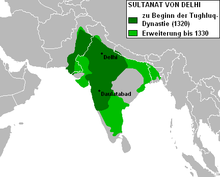
- 623: The Islamic calendar begins with the Hejra. Within a very short time, the Arabs under the Umayyads conquered the Old World from the Pyrenees (721) to the Indus (Sindh 712). Under the Abbassids and the Samanids who broke away from them further in eastern Iran, Turks are increasingly being used as soldiers, who are increasingly rising into the power elite. Islam is spreading rapidly among the Turks in Central Asia.
- 1055: In the east (Iraq and Iran) the Sunni Turkish Seljuks rise . The Abbasid caliph changes into a more religious head of the Islamic world, which henceforth can be divided into three spheres of power with Baghdad (Seljuks), Cairo ( Fatimids ) and the Maghreb with different dynasties. Yet religion and a common urban culture unite Muslims.
- 1001: Under Mahmud, the Turkish Ghaznavids begin to invade northern India. Their opponents are the Hindu Rajputs living in northwest India and their kingdom of Pratihara . India had not come under the control of a great empire since the Gupta. In addition to the Rajputs, the Pala Empire existed in Bengal, in the Dechan that of Chalukya and later Rashtrakuta , and in South India one after the other Pallava , the important Chola and Pandya . In addition, the Sinhalese Empire of Anuradhapura existed in Sri Lanka .
- 1206: Another Turkish warlord completes the conquest and founds the Sultanate of Delhi , which conquers northern India and parts of the Dean. In contrast, there were the Hindu empires of Gajapati in Orissa and Vijayanagara in southern India. Around 1345 the Bahmani Sultanate split off from Delhi.
The Mongols, 13th and 14th centuries
The mighty conquest of the Mongols leads to a great empire under whose protection the Silk Road regains importance. The so-called "pax mongolica" allows Europeans to travel safely to China and, above all, the travel reports of the Italian businessman Marco Polo (" Il Milione ") and Wilhelm von Rubruk and Giovanni Carpini , who are entrusted with diplomatic missions, open up Europe's knowledge of the for the first time Far East.
- 1206: Temüdschin (Genghis Khan) unite the Mongol tribes and invade China in 1211 without being able to conquer it first. He turned to the west and defeated the Kara-Kitai, whose empire had already collapsed, the Khorezm-Shahs, and reached Christian Georgia and southern Russia before he returned to the east and conquered the empire of the Hsia-Hsia. According to Turkish tradition, the empire is divided into feudal areas among the sons. Under the new Khan Ögödei, Karakoram becomes the residence of the Mongols and he makes use of members of various subjugated cultural peoples such as the Chinese and Arabs to establish an administration.
- 1258: The Mongols under Möngke finally destroy the Abbassid caliphate and conquer Baghdad. Around the same time, his brother Khubilai conquered the southern part of China.
- around 1300: The Mongolian Empire falls apart. In southern Russia, the already Islamized part of the Golden Horde becomes independent under the ruler Uzbek. In the course of the 15th century, the empire split into several khanates, which were gradually conquered by the expanding Grand Duchy of Moscow. The Chagatai Khanate was formed in Central Asia, that of the Ilkhan in Iraq and the Empire of the Mongolian Yuan dynasty in China .
- 1363: The conqueror Timur Lang conquered large parts of Iraq, Iran and Central Asia. He founded the Timurid dynasty . But already after the death of his successor, the empire begins to decline. In southern Central Asia, Turkish-Mongolian groups begin to expand, initially referred to as Uzbeks and then part of these associations, which spread as Kazakhs .
Japan
In Japan, the first state structure emerged in the 4th century with the Yamato Empire . With the Nara period in the 8th century, the classical period of Japanese antiquity begins, in which the ruler, in contrast to the cultural supremacy of China, calls himself Tennō , i.e. an emperor with equal rights. During the Heian period between 794 and 1185, the Fujiwara family gained power and provided rulers. In the subsequent Kamakura period , the battle for power in the Gempei War was fought between the Taira and Minamoto families , the latter won and the first shogunate established. From now on Japan is a strongly feudal empire with a strict administration led by a regent and a noble warrior caste, the samurai .
South East Asia
While the area of what is now Vietnam was under Chinese influence, the more southern and eastern parts of Southeast Asia were exposed to strong Indian influence. In addition to the Vietnamese empires, the Champa people settled in South Vietnam . Apparently, Hinduism and Buddhism were deliberately used to legitimize the rulers (so-called mandala empires ) that gradually emerged on the basis of intensive rice cultivation, but which were far from being territorial rulers . As in early Mesopotamia, temples initially played an important economic role.
- around 700: Sumatra seems to be the starting point of the maritime empire or confederation of states of Srivijaya .
- 802: The first documented coronation of a Khmer ruler as king indicates a gradual strengthening of the rule of the mandala kingdoms.
- 900: In what is now Myanmar in the Irrawady Valley, the Pyu Pagan Empire emerges .
- 1009: After the fall of the Tang dynasty, an independent indigenous empire emerges again in North Vietnam: Dai Viet .
- 1080: An upheaval seems to have taken place in the Khmer empire, bringing a dynasty to power. Around 1150, the famous temple complex of Angkor Wat was built under a ruler of the new dynasty .
- around 1200: The successor empire of Taruma (see Sailendra ), Singhasari and later Majapahit on Java ousted Srivijaya as the hegemonic power of the Southeast Asian island world.
- around 1270: The Pagan Empire begins to get into trouble. The kingdom of Pegu established itself as the successor state in Unterirma, which is opposed to the empire of Ava in Oberbirma, founded a few years later .
- around 1300: The pressure of the Mongol conquests leads to the migration of the Shan and Thai peoples , which leads to the establishment of several empires .
- around 1400: Malacca is founded.
Modern times
The determining event from 1500 AD onwards is European colonialism, which leads to complete supremacy of Europe in the 19th century. The exaggeration of imperialism and racism ultimately leads to the two world wars, after and during which Europe no longer has the strength to defend itself against aspirations for independence. The decolonization that began was partly peaceful, as in India, albeit not without resistance, but partly also extremely bloody as in Algeria and Vietnam. (see European expansion ) The interest of the Europeans was initially directed solely to the control of trade. It was not just about creating a monopoly in the spice trade, but also about intervening in intra-Asian trade in order to reduce the need for silver for the loss-making trade with southern India by generating profits. Pepper, cloves, nutmeg and cinnamon initially played the main roles.
Asia at the beginning of the European voyages of discovery
The spread of gunpowder and with it musketeers and cannons at the end of the 15th century led to the emergence of the three great Islamic empires of the Ottomans, Safavids and Great Mughals. The Ming in China completes the picture of the great empires of Asia that the Europeans face. All of these empires are affected by the so-called "Little Ice Age" in the 17th century.
- 1451: With the accession of Mehmed II to power , the Ottoman emirate, which has been expanding in Anatolia and the Balkans since the 14th century, becomes the Ottoman Empire . In 1453 the conquest of Constantinople succeeds, which becomes the capital and the new empire expands to Persia, Egypt and Vienna by the middle of the 16th century (siege of 1529). The strength of the empire is based on the benefices given to soldiers (timar system) and the elite troops of the janissaries who are subordinate to the sultan . With the end of the expansion, there is a shortage of land that weakens the timar system. Expensive wars exacerbate the problems, so that the empire plunges into an internal crisis as a result. From the middle of the 17th century, capable grand viziers carried out reforms that enabled the Ottomans to undertake a second phase of attempted expansion against the Habsburgs, Persians and Russians, before the empire finally became defensive in foreign policy in the 18th century (" tulip time ").
- 1501: Shah Ismail I founds the Safavid dynasty. The dynasty experienced its heyday around 1600. The creation of a standing army with the advantage of field artillery made it possible to recapture areas of the Ottomans. The Safavids are Shiite, but religiously tolerant nonetheless. With the decline in intercontinental trade over land caused by the Europeans, the power of the Safavids declines. In 1722 there was an uprising among Afghan tribes , who were pushed back by Nadir Shah (1736–1747). After his assassination, an independent Afghanistan is formed . In Persia after protracted succession struggle in 1796, the dynasty following Qajar .
- 1526: The Timurid prince Babur, oppressed by the Uzbeks, begins the conquest of the Sultanate of Delhi and establishes the empire of the Mughals . Under Akbar since 1556, the empire continued to expand until it dominated large parts of India. Its administrative reforms and religious tolerance towards the Hindus create a permanent basis for the empire. In the 18th century there was a decline that was made clear by Nadir Shah's conquest of Delhi in 1739. The Mughals' crisis can be used by the Hindu Marathas in the Dechan to fight for their independence and the Afghans to conquer the north of the subcontinent.
- 1368: The Ming dynasty succeeds in driving out the Mongols and establishing a new, strict rule over all of China. An initially expansive policy, characterized by expeditions to Central Asia, Vietnam and across the sea under Admiral Zheng He, met with little success. In 1449 the Ming emperor was captured after a battle against the Oirats and from then on the Ming only acted defensively. The Great Wall is being expanded. An economic decline at the beginning of the 17th century led to a weakening of the resistance and the Manchu , who emerged from the Jurchen, succeeded in conquering Beijing in 1644.
- 1592: Korea of the Joseon Dynasty is almost conquered by Japan, until an army of Chinese liege lords, the Ming, succeeds in driving the Japanese out again. In Japan, the Ashikaga shogunate followed shortly afterwards , the Tokugawa, among whom Japan enjoyed a period of peace between 1603 and 1868, but also closed itself off from the outside world.
- 1644: Under the Qing dynasty , an attempt is made to resist the Sinization. The Chinese administrative system is retained, but occupied by Manchu throughout. In the 18th century they succeeded in enforcing their rule in the remote provinces and as far as Tibet. With the Europeans, corn, sweet potatoes and peanuts came to China and enabled renewed population growth through the expansion of agricultural areas.
- Southeast Asia: Among the Thai states, the kingdom of Ayutthaya gained supremacy in the 16th century , from which the kingdom of Siam emerged, which rivaled Burma and the Vietnam of the Lê dynasty (ruled by the families of the Nguyen and Trinh).
The Portuguese trading empire, 16th century
- 1498: The voyage of discovery Vasco da Gamas opens the sea route to India for the Portuguese. However, the established trading empire of the crown could not completely control the spice trade. At least the Portuguese achieve a fair share of the spice trade alongside that of the Indian, Persian and Arab spice trade, which reaches Europe via the intermediate trade in Venice. Trade between China and Japan was among the most profitable, aided by the prohibition of the Chinese rulers to do business. The Portuguese founded or conquered a number of bases: 1510 Goa , 1515 Hormuz , 1511 Malacca . 1557 Macau .
Russia's Expansion into Siberia and Central Asia, 16th to 19th Centuries
- 1552: With the conquest of the Tatar Khanate of Kazan and two years later that of Astrakhan , the Russian expansion into Asia begins. The last remnants of Mongolian rule in what was later to be Russia are thus eliminated. Only the Crimea initially escaped Russian conquest (until 1783). The driving force behind the expansion is the Russian fur traders who advance into Siberia and reach the Pacific in 1649. Further south in Central Asia, the Russians became the protective power of the Kazakh khanates from 1700 onwards, who were harassed by the last typical nomadic peoples on the move, the Torghuts, who founded the Kalmuck Horde , and the Oirats . In the middle of the 19th century, the Russians continued to increase their influence until they had de facto annexed the khanates. A short time later the Russians also force the Uzbek khanates of Bukhara , Khiva and Kokand , which had existed since around 1700, under their influence; The last ones were finally conquered only after the Russian Revolution in 1920.
The East India Companies, 17th and 18th centuries
- 1600/1602: After the founding of the English and Dutch East India Companies , the new Northern European trading nations take the place of Portugal.
- 1641: The starting point of the Dutch colonies in Southeast Asia was the conquest of Malacca. They concentrated on the Southeast Asian island world, from which they drove the Portuguese and tried, among other things, by conquering the cultivation areas or even destroying those that they could not bring under control, at least partially successfully to achieve a monopoly position for certain spices.
- 1757: In the course of the 17th century, the indigestion of India, which was initially forced by competition from the Dutch, turned more and more into an advantage for the English, when cloth, indigo, tea and porcelain increasingly questioned the role of spices as the most important commercial goods. During the Seven Years' War , the British East India Company gained the upper hand over its French rivals in the Battle of Plassey and dominated Bengal in the East Indies. Now an increased territorial expansion begins, taking advantage of the rivalries of the Indian princes who had inherited the Mughal empire (Marathen). The power of the East Indian Company is increasingly based on property taxes. An expression of the company's new role as territorial lords is the appointment of a governor general and administrative reform. The Sepoy uprising of 1857 is quickly transformed from a religiously motivated uprising into India's first struggle for independence. After the almost defeat, the company is dissolved.
European domination and decolonization in the 19th and 20th centuries
The lands and bases, which had been taken over primarily to control trade, turned into colonial rule by Europeans towards the end of the 18th century.
West asia
- The Ottoman Empire had to recognize the independence of the Greeks with the Peace of Edirne in 1829. This and other uprisings, as well as the Crimean War against the Russians, led to a serious crisis and in 1875 to national bankruptcy. The movement of the "Young Turks" sought to modernize the country, but led the country alongside the Germans in the First World War . The Arab uprising played a not insignificant role in the Turkish defeat, which eventually ended in the founding of Turkey by Kemal Ataturk. On the basis of the Sykes-Picot Agreement , Great Britain received the British mandate for Mesopotamia on what is now Iraq and the League of Nations mandate for Palestine , while the French zone of influence included the League of Nations mandate for Syria and Lebanon . The British Balfour Declaration , which was initially recognized by the Arab side in the Faisal-Weizmann Declaration , was followed by the UN partition plan for Palestine in 1947, under the influence of the Holocaust, and the establishment of the State of Israel in 1948 , which triggered the Middle East conflict that continues to this day .
- In Persia there was a revolution in 1925 under Reza Khan, who resigned after a brief occupation of the country during the Second World War by the British and Soviets. 1979 comes the so-called Islamic Revolution.
- Afghanistan split politically in the course of the 19th century. The emerging emirate of Kabul resisted an attempt at conquest by the British, who in 1907 confirmed Afghanistan's independence in a treaty with the Russians . Shah Amanullah Han tried to modernize the country unsuccessfully in 1927. Major internal problems led to the coup in 1973 and leaned against the Soviet Union and finally the civil war.
India
In 1885 the National Congress was founded as an institution of the independence movement. Mahatma Gandhi became a symbol of resistance at the beginning of the 20th century and repeatedly embarrassed British rule with his concept of non-violence ( ahimsa ); But it was not until the end of the Second World War and the change of government in England that India became independent in 1948 . The strong Islamic movement under Jinnah enforces the division and establishment of an Islamic state, which falls apart in the course of the conflict over Kashmir in Pakistan and Bangladesh .
East asia
- 1842: The Opium War opens up Chinese ports to the European powers.
- 1858: Another expedition leads to the Treaty of Tianjin and another violent opening of the country.
- 1868: Japan took a different turn, forced to conclude trade agreements after opening by the American Commodore Perry , but took modernization into its own hands after the Meiji Restoration in 1867.
- 1895: The war between Japan and China ends with the latter's defeat and the surrender of Formosa. This triggers an attempt at reform, the failure of which is caused by the Boxer Rebellion, which is directed against foreigners in the country and is crushed by a European expeditionary force in 1900.
- 1905: Russo-Japanese War . Japan wins and military tendencies are increasingly prevalent in foreign policy.
- 1910: Japan annexes Korea. South Korea gained independence in 1948, which led to the counter-establishment of communist North Korea , which in 1950 triggered the Korean War with its attack on the south .
- 1911: The Sun Yat Sens revolution leads to a time of warlords in which the Kuomintang and later the communists take the leading role. In Japan, the newly acquired strength led to militaristic imperialism, which led to the establishment of the vassal state of Manchukuo and, from 1937, to the invasion of China. With that the Pacific War begins . The complete defeat of Japan favors the victory of the communists and the establishment of the People's Republic of China , which annexed Hainan and Tibet , as well as other former European colonies conquered by Japan during World War II.
- 1919: Japanese invasion of Manchuria.
South East Asia
- 1858: The French, present in Southeast Asia since the 17th century, begin to conquer Indochina.
- 1937: The British-occupied Myanmar receives extensive autonomy rights and becomes finally independent after the Second World War.
- 1945: Cambodia declares independence and is recognized by France in 1949 because of the conflict over Vietnam. In the course of the Vietnam War , Sihanouk was overthrown in 1970, the Viet Minh exerted influence and the Khmer Rouge revolted in 1973 .
- 1946: The British invade Vietnam to prepare for the return of the French. Negotiations on the country's status fail and the French are drawn into a colonial war that ends with their defeat in 1954. The country is divided and a civil war ensues, which leads to the Vietnam War with the involvement of the Americans due to the East-West conflict.
- 1946: The former Spanish colony in the Philippines , a protectorate of the United States since 1898, becomes independent after temporary Japanese occupation.
- 1949: Indonesia , declared independent after the Japanese occupation, is finally recognized after several Dutch "police actions".
General developments after the Second World War
- East-West Conflict, Korean War, Vietnam and Afghanistan
- Modernization attempts in China, the big leap, the beginning of a market economy opening together with political repression
- The economic rise of Japan and the tiger states
- Indian democracy, the non-aligned states
- Arab nationalism and the Palestine conflict
literature
- Geoffrey Barraclough (ed.): Knaurs great historical world atlas. (Original: The Times Atlas of World History ) Droemer-Knaur, Munich 1979, ISBN 3-426-26016-6 .
- Martin Krieger: History of Asia. Böhlau-Verlag (UTB), Cologne 2003, ISBN 3-8252-2382-5 .
- Donald Johanson, Blake Edgar: Lucy and Her Children. Spektrum Verlag, Berlin 1998, ISBN 3-8274-1049-5 .
- Steve Olson: Origin and History of Man. Berlin Verlag, Berlin 2003, ISBN 3-8270-0500-0 .
- Albert Hourani : The History of the Arab Peoples. Fischer (Tb.), Frankfurt 2001, ISBN 3-596-15085-X .
- Hermann Kulke , Dietmar Rothermund : History of India. 2nd Edition. Beck Verlag, Munich 1998, ISBN 3-406-43338-3 .
- Jacques Gernet : The Chinese World. Suhrkamp Verlag (Insel-Verlag), Frankfurt 1997, ISBN 3-518-38005-2 .
- Gottfried-Karl Kindermann : The rise of East Asia in world politics 1840-2000. Deutsche Verlags-Anstalt, Munich 2001, ISBN 3-421-05174-7 .
